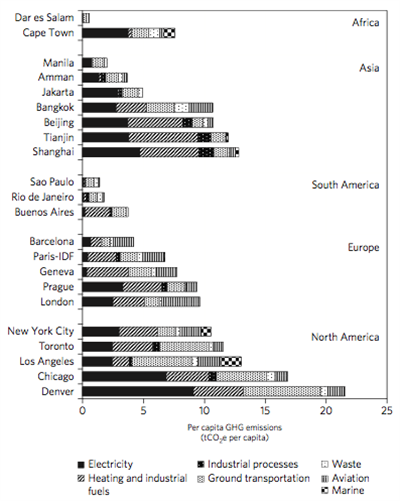Mat Hope
17.03.2014 | 12:30pmFrom London’s bright lights to LA’s jammed highways, no two cities are alike. And the way they go about cutting their greenhouse gas emissions should be just as unique, a new paper argues.
Cities are responsible for around 75 per cent of the world’s carbon dioxide emissions. So if policymakers are going to keep to internationally-agreed climate pledges, they’re going to have to cut urban emissions.
But there’s no one-size-fits-all solution to reducing a cities’ emissions, according to a new paper published in Nature Climate Change today. It looks at 22 cities across the globe, and tries to work out how climate policies can be tailored to fit each places “unique characteristics”.
Comparing emissions
Some cities are much more polluting than others. To work out how to design city-specific climate policies, the researchers first looked at where each city’s emissions come from.
The graph below shows the average emissions per person across the 22 cities the study looked at. Each bar shows how much cities emit per resident and is separated by the sector the emissions come from, such as electricity, heating, and transport:
The wealthiest cities tend to have the highest emissions as their residents generally use more energy, the study finds.
As you can see, big US cities such as Denver, Chicago and Los Angeles have much higher emissions per resident than than less wealthy cities in Africa and South America. Likewise, China’s sprawling megacities have much higher emissions per capita than their neighbours in Southeast Asia.
The paper identifies three factors in particular which affect each city’s emissions: how tightly packed together residents are, how the city’s residents get around, and where each city gets its electricity from.
The 22 cities included in the study were all pretty different based on those criteria. Some cities – such as Denver and Chicago – are sparsely populated but use very polluting energy sources. Others – like Barcelona – are very tightly packed but get a lot more electricity from low carbon sources.
Working out how these differences affect emissions means the researchers can recommend climate policies to help cities to reduce emissions in the most efficient way, the paper says.
Different strategies
Since Barcelona is pretty different to Beijing, local governments should implement different climate policies, the paper says. In particular, policymakers need to pay attention to how densely populated a city is and where it gets its electricity from, according to the research.
The chart below shows which policies – from switching to electric vehicles, to installing solar panels on buildings – will work better in each city. The cities are divided into four quadrants based on how tightly packed their residents are – population density (the x axis) – and how polluting their electricity generation is (the y axis).
Cities such as Denver and Chicago which have sparser populations and get their electricity from highly-polluting energy sources should focus on installing solar panels, the paper claims. That’s partly because their buildings have a lot more access to sunlight than tightly-packed cities like London, meaning solar power should work better, the paper argues.
In contrast, in cities with dense populations but relatively clean electricity generation – such as Barcelona and Buenos Aires – policymakers should develop low carbon transport systems to get the population out of their fossil-fuelled cars, the paper says. The researchers also recommend trying to replace natural gas heating systems with heat pumps, which get energy from the ground or air and have much lower emissions.
Other policies such as switching from diesel or petrol-powered vehicles to electric cars, or importing electricity generated from renewable sources from lower carbon neighbours, could also help cities reduce emissions, the paper says.
So while each city is different, the paper suggests there’s a pick-and-mix of climate policies just waiting for local governments to get stuck into.
Will and wealth
But while the paper shows cities of all shapes and sizes can reduce their emissions, it acknowledges that not all will be able to do so.
Many of the policies the paper recommends need large amounts of government money, which can be in short supply. Moreover, local governments will need to prioritise climate policy if action is to be taken, the paper argues – which is far from guaranteed.
So on top of all their other differences, variations in each city’s will and wealth is likely to be a key factor in determining which low carbon path policymakers choose.



